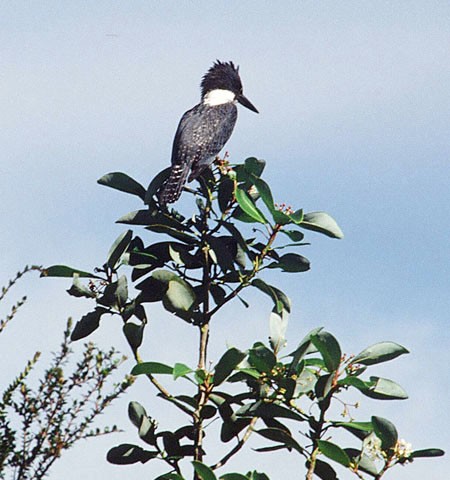Ringed Kingfisher
A species of Large Crested Kingfishers Scientific name : Megaceryle torquata Genus : Large Crested Kingfishers
Ringed Kingfisher, A species of Large Crested Kingfishers
Botanical name: Megaceryle torquata
Genus: Large Crested Kingfishers
Content
Description People often ask General Info
Description
The ringed kingfisher (Megaceryle torquata) is a Neotropical kingfisher that lives in habitats ranging between the US and Mexico. In 1888, the species was first discovered in the US, while the first ringed kingfisher nest was found in 1970. They are commonly seen along the Rio Grande and in water bodies in southern Texas. Their distribution is increasing and expanding upwards. 
Size
39-42 cm (15.5-16.5 in)
Nest Placement
Burrow
Number of Broods
22 days
Feeding Habits
Ringed Kingfisher's diet primarily includes freshwater fish, crustaceans, amphibians, reptiles, and large insects. They dive to capture prey by submerging their head and bill, hunting from perches or occasionally hovering. Prey is typically 3–4 inches, although up to 8 inches long and swallowed head first. Feeding occurs mainly near shallow water edges.
Habitat
Ringed Kingfisher thrives in a range of aquatic environments, primarily favoring clear streams, rivers, lakes, and estuaries, but also frequents calm seas, mangroves, and inland waters. They utilize perches with clear visibility like bare trees or utility wires to scout for prey. Habitats with shaded streams are typically avoided. Nesting occurs in burrows along riverbanks, and their geographical spread encompasses offshore reefs and fjords in Middle and South America.
Nest Behavior
Ringed Kingfisher excavates burrows to nest, laying eggs in the bare-earth depression. Both parents excavate and later care for the eggs and young.
Nest Characteristics
Ringed Kingfisher's nest is at the end of a 9-foot burrow in a riverbank, with a 5-inch entrance above the high-water mark. The nest is a simple depression in bare earth.
Dite type
Piscivorous
People often ask
General Info
Feeding Habits
Bird food type
Sounds
Call
Recording location: Brazil
Call
Recording location: Costa Rica
Behavior
Ringed Kingfisher are primarily solitary, with notable social interaction observed during the breeding season when they engage in courtship rituals such as fish presentation. These birds demonstrate social monogamy and shared responsibilities in nest excavation, incubation, and chick nurturing, including a collaborative exchange signaled by distinct calls. Though territorial defense is rare, ringed Kingfisher will protect their nesting sites. Outside the breeding season, ringed Kingfisher exhibit less territorial behavior, occasionally confronting competitors but mainly displaying skittishness, often vocalizing loudly when disturbed.
Distribution Area
Ringed kingfishers are found in broad areas between Texas, USA and South America. The ranges of ringed and belted kingfishers overlap from Central America and above for 6–8 months. Ringed kingfishers also have ranges that overlap with other kingfisher species in Central and South America. Breeding ranges of ringed kingfishers vary in the Neotropics in Mexico, the Caribbean and South America. Their preference for mangrove habitats has been observed in the tropics. Foraging occurs offshore as far as 1 km (.7 mi). Overwintering areas are indifferent to breeding ranges, but are able to forage farther than during their breeding periods. Large irrigation canals in Rio Grande, Texas have been used as wintering grounds by such species. They are usually found in areas with high fish densities during the dry season. 
Species Status
The IUCN considers the ringed kingfisher to be of “Least Concern”. Increasing population trends indicate that the species are not vulnerable as they are widespread and have a large habitat distribution and breeding ranges. 
